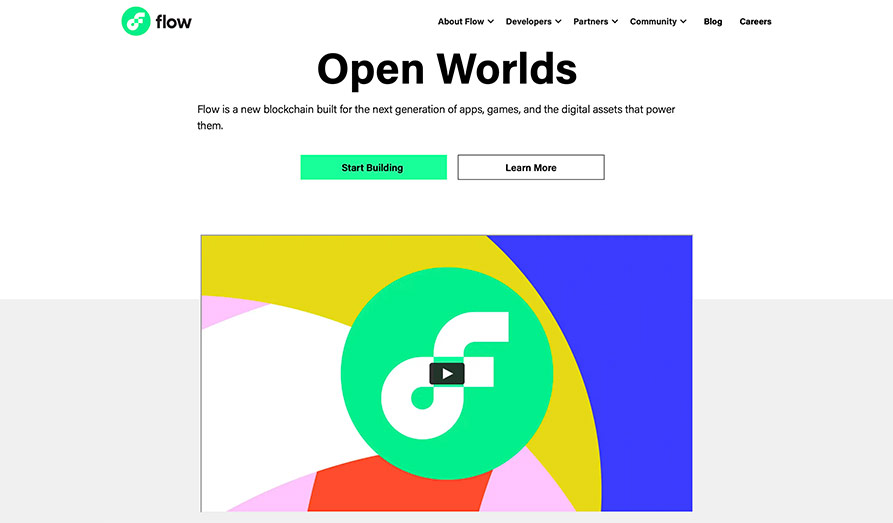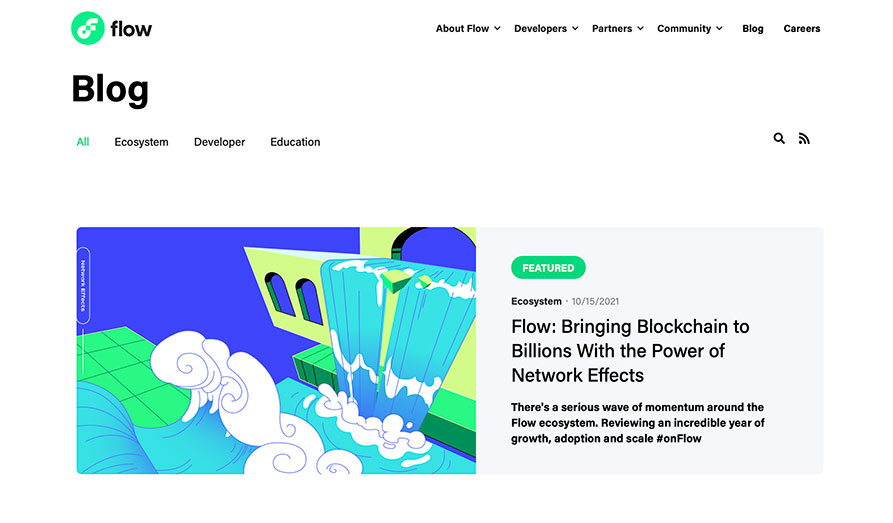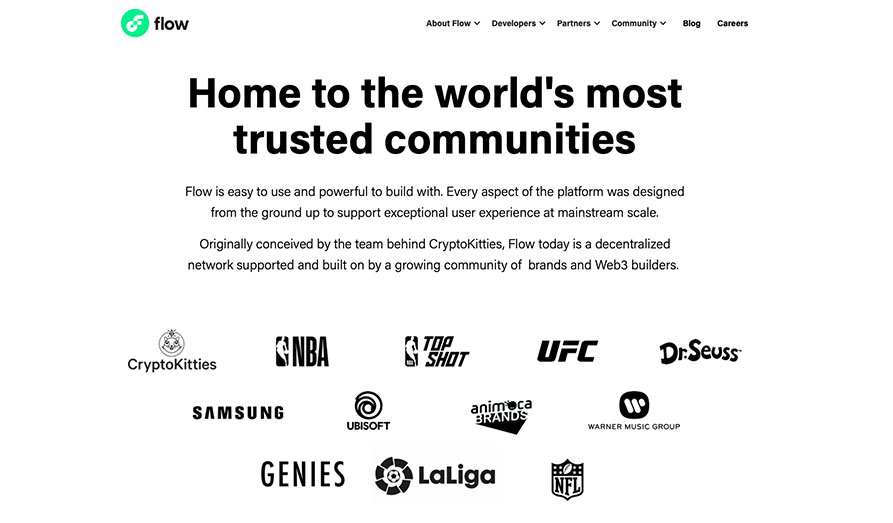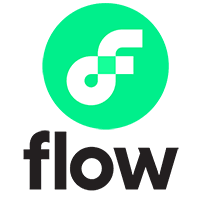
Flow Blockchain is familiar for its ease of use and the PoS mechanism. The blockchain aims at ensuring that developers can easily create their dApps and businesses. Besides, it rethinks most design choices to guarantee the usability of the blockchain for both consumers and developers. These changes include human-readable security, smart contracts, and more. The result is that all processed transactions get a full ACID guarantee. With this approach, the network has made it easier for developers to safely and efficiently reuse the code from other developers. This helps new developers create new products at an accelerated pace.
Briefly about Flow Blockchain
The network was developed by the team that created CryptoKitties, Dapper Labs, in 2019. The developers aimed at creating a developer-friendly network that can be the foundation for the next generation of non-fungible tokens (NFTs), digital assets, games, and dApps. Furthermore, the team was able to solve scalability issues without sharding. They achieved this by using a unique architecture that helped deliver massive improvements in throughput and speed. With the blockchain, developers can now build unique and new crypto-enabled dApps and businesses. The available Flow applications help consumers to retain control over their data, thus allowing them to create and trade NFTs. Besides, the network implements Cadence, a programming language that helps with smart contracts. The existing node architecture also helps with speed and throughput improvements, thus eliminating the need for layer two solutions.
Flow stands out as one of the top blockchains for NFTs.CryptoLists.com
Flow is a recently launched network/platform that helps create crypto enables consumer applications. This entails games and digital assets used within these games. The platform understands that the games can have many users; thus, they focus on creating a fast platform with high throughput. The platform is unique because it’s created with four pillars in mind. They include consumer onboarding, developer ergonomics, resource-oriented programming, and multi-role architecture. +Consumer onboarding - The network was built for mainstream consumers. Therefore, it can offer payment onramps with a safe and low friction crypto path. +Developer ergonomics- The network offers upgradeable smart contracts with built-in logging support for their emulator. +Resource-oriented programming – The platform utilizes a new language called Cadence. The language helps write the smart contracts, and it's safer for users and easier for developers. The goal of Cadence is to offer simplicity, auditability, safety, and security. It achieves this by focusing on the usability and productivity of developers, thus helping them write code and provide good tooling easily. Besides, it also helps with readability by ensuring that developers can easily verify the code while making their intentions explicit. +Multi-role architecture – The network is designed to scale billions of users without sharding. Therefore, it doesn’t reduce the decentralization of its existing consensus mechanism.
Utility of Flow Blockchain?
The network can be used by both developers and consumers. Developers can use the platform to create crypto-enabled businesses and dApps. Besides, they can do so while enjoying the massive improvements of throughput and speed of the network. On the other hand, customers can use the network to maintain control over their own data. Besides, customers can create non-fungible tokens that they can trade on multiple open markets around the world. The network also allows its users to create user-owned open economies. Therefore, the value of the system is also created by the users.
Flow Blockchain
Flow Blockchain Consensus Method: Proof of Stake
Release Date: October 10, 2017
Advantages at Flow Blockchain
 + Low transaction costs of 0.000001 FLOW.
+ Low transaction costs of 0.000001 FLOW.+ Proof of stake mechanism.
+ Over 1,000 transactions per second and a goal of over 10,000.
+ User-friendly interface.
Disadvantages
- Not so well known outside the NFT space.
Costs
▪ Rated at 10/10Besides having more transactions per second than other blockchains, the network also aims at reducing transaction costs. With other blockchains having higher transaction fees of up to $20, Flow has a transaction fee of 0.000001 FLOW. However, users get to pay a second charge of $0.03 or 0.001 FLOW to create an account. The network achieves these low rates due to their human-readable smart contracts. The transations are fast, easy and secure and everything is verified using the verification nodes and verified by a network consensus.
Reputation and Buzz
▪ Reputation rated at 9/10▪ Buzz rated at 9/10
Since its adoption, the blockchain has been focused on creating a user-friendly interface that can simplify the process of creating projects. Therefore, this makes the network suitable for most people since even newbies can learn how to develop dApps while interacting with the platform. Besides, the network has a positive reputation in the NFT world since it helps power these projects. Most users prefer the network because of its multi-node, multi-role architecture that creates division of labor, thus increasing efficiency while eliminating redundancy.
FAQ
Who created Flow Blockchain?
Flow Blockchain was created by Dapper Labs, the team behind the successful CryptoKitties. The team aimed at creating a cheaper and faster framework than the Ethereum Blockchain.
Is Flow Blockchains proof of stake?
Yes, the network uses a Proof of Stake (PoS) mechanism.
Will Flow Blockchains overtake Ethereum Blockchain?
Yes, the network can overtake Ethereum Blockchain for at least NFTs, as long as it retains its low transaction and transfer costs while solving the main scalability issue that Ethereum suffers.
Screenshots from Flow Blockchain
Native crypto coin for this blockchain? Learn more about Flow (FLOW)
 FLOW is the native coin for Flow Blockchain. It is therefore also worth reading more about that on the link below.
FLOW is the native coin for Flow Blockchain. It is therefore also worth reading more about that on the link below.›› Read our full Flow review here


 What is main risk & potential for Flow?
What is main risk & potential for Flow?

























